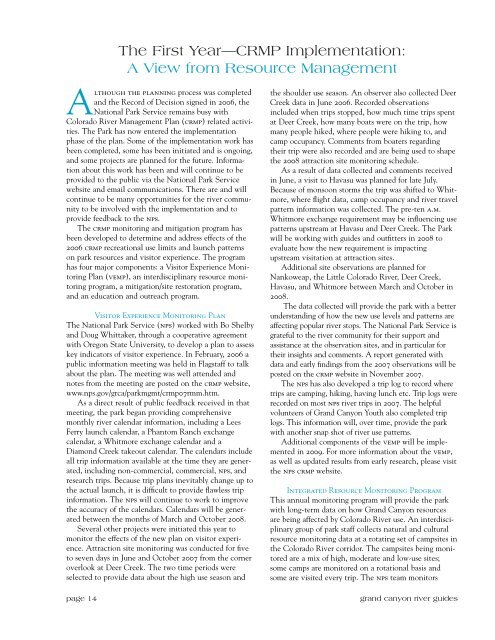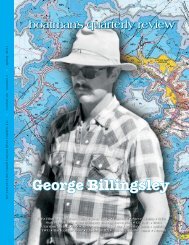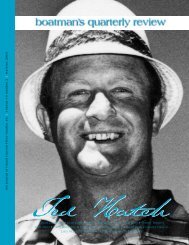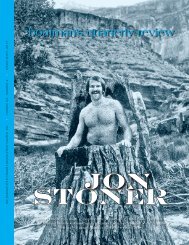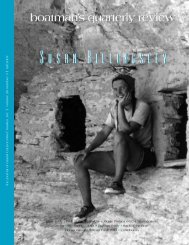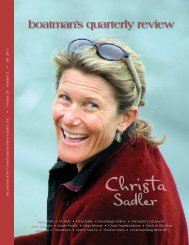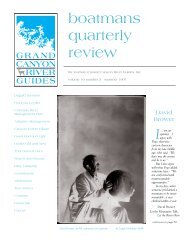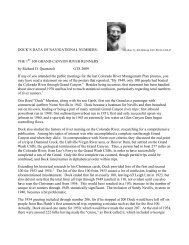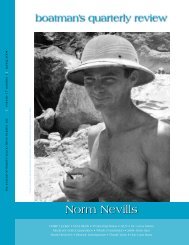winter 07-08 / 20:4 - Grand Canyon River Guides
winter 07-08 / 20:4 - Grand Canyon River Guides
winter 07-08 / 20:4 - Grand Canyon River Guides
Create successful ePaper yourself
Turn your PDF publications into a flip-book with our unique Google optimized e-Paper software.
The First Year—CRMP Implementation:<br />
A View from Resource Management<br />
Although the planning process was completed<br />
and the Record of Decision signed in <strong>20</strong>06, the<br />
National Park Service remains busy with<br />
Colorado <strong>River</strong> Management Plan (crmp) related activities.<br />
The Park has now entered the implementation<br />
phase of the plan. Some of the implementation work has<br />
been completed, some has been initiated and is ongoing,<br />
and some projects are planned for the future. Information<br />
about this work has been and will continue to be<br />
provided to the public via the National Park Service<br />
website and email communications. There are and will<br />
continue to be many opportunities for the river community<br />
to be involved with the implementation and to<br />
provide feedback to the nps.<br />
The crmp monitoring and mitigation program has<br />
been developed to determine and address effects of the<br />
<strong>20</strong>06 crmp recreational use limits and launch patterns<br />
on park resources and visitor experience. The program<br />
has four major components: a Visitor Experience Monitoring<br />
Plan (vemp), an interdisciplinary resource monitoring<br />
program, a mitigation/site restoration program,<br />
and an education and outreach program.<br />
Visitor Experience Monitoring Plan<br />
The National Park Service (nps) worked with Bo Shelby<br />
and Doug Whittaker, through a cooperative agreement<br />
with Oregon State University, to develop a plan to assess<br />
key indicators of visitor experience. In February, <strong>20</strong>06 a<br />
public information meeting was held in Flagstaff to talk<br />
about the plan. The meeting was well attended and<br />
notes from the meeting are posted on the crmp website,<br />
www.nps.gov/grca/parkmgmt/crmp<strong>07</strong>rmm.htm.<br />
As a direct result of public feedback received in that<br />
meeting, the park began providing comprehensive<br />
monthly river calendar information, including a Lees<br />
Ferry launch calendar, a Phantom Ranch exchange<br />
calendar, a Whitmore exchange calendar and a<br />
Diamond Creek takeout calendar. The calendars include<br />
all trip information available at the time they are generated,<br />
including non-commercial, commercial, nps, and<br />
research trips. Because trip plans inevitably change up to<br />
the actual launch, it is difficult to provide flawless trip<br />
information. The nps will continue to work to improve<br />
the accuracy of the calendars. Calendars will be generated<br />
between the months of March and October <strong>20</strong><strong>08</strong>.<br />
Several other projects were initiated this year to<br />
monitor the effects of the new plan on visitor experience.<br />
Attraction site monitoring was conducted for five<br />
to seven days in June and October <strong>20</strong><strong>07</strong> from the corner<br />
overlook at Deer Creek. The two time periods were<br />
selected to provide data about the high use season and<br />
page 14<br />
the shoulder use season. An observer also collected Deer<br />
Creek data in June <strong>20</strong>06. Recorded observations<br />
included when trips stopped, how much time trips spent<br />
at Deer Creek, how many boats were on the trip, how<br />
many people hiked, where people were hiking to, and<br />
camp occupancy. Comments from boaters regarding<br />
their trip were also recorded and are being used to shape<br />
the <strong>20</strong><strong>08</strong> attraction site monitoring schedule.<br />
As a result of data collected and comments received<br />
in June, a visit to Havasu was planned for late July.<br />
Because of monsoon storms the trip was shifted to Whitmore,<br />
where flight data, camp occupancy and river travel<br />
pattern information was collected. The pre-ten a.m.<br />
Whitmore exchange requirement may be influencing use<br />
patterns upstream at Havasu and Deer Creek. The Park<br />
will be working with guides and outfitters in <strong>20</strong><strong>08</strong> to<br />
evaluate how the new requirement is impacting<br />
upstream visitation at attraction sites.<br />
Additional site observations are planned for<br />
Nankoweap, the Little Colorado <strong>River</strong>, Deer Creek,<br />
Havasu, and Whitmore between March and October in<br />
<strong>20</strong><strong>08</strong>.<br />
The data collected will provide the park with a better<br />
understanding of how the new use levels and patterns are<br />
affecting popular river stops. The National Park Service is<br />
grateful to the river community for their support and<br />
assistance at the observation sites, and in particular for<br />
their insights and comments. A report generated with<br />
data and early findings from the <strong>20</strong><strong>07</strong> observations will be<br />
posted on the crmp website in November <strong>20</strong><strong>07</strong>.<br />
The nps has also developed a trip log to record where<br />
trips are camping, hiking, having lunch etc. Trip logs were<br />
recorded on most nps river trips in <strong>20</strong><strong>07</strong>. The helpful<br />
volunteers of <strong>Grand</strong> <strong>Canyon</strong> Youth also completed trip<br />
logs. This information will, over time, provide the park<br />
with another snap shot of river use patterns.<br />
Additional components of the vemp will be implemented<br />
in <strong>20</strong>09. For more information about the vemp,<br />
as well as updated results from early research, please visit<br />
the nps crmp website.<br />
Integrated Resource Monitoring Program<br />
This annual monitoring program will provide the park<br />
with long-term data on how <strong>Grand</strong> <strong>Canyon</strong> resources<br />
are being affected by Colorado <strong>River</strong> use. An interdisciplinary<br />
group of park staff collects natural and cultural<br />
resource monitoring data at a rotating set of campsites in<br />
the Colorado <strong>River</strong> corridor. The campsites being monitored<br />
are a mix of high, moderate and low-use sites;<br />
some camps are monitored on a rotational basis and<br />
some are visited every trip. The nps team monitors<br />
grand canyon river guides


